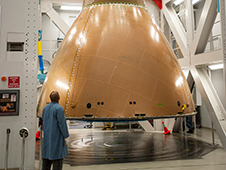
NASA engineers and contractors have begun tests on NASA’s Launch Abort System (LAS) Fairing Assembly, flight hardware that will be used to cover and protect the Orion crew module during Exploration Flight Test-1 (EFT-1), scheduled for September 2014.
Similar to the material of a graphite tennis racquet, the LAS fairing is a lightweight composite structure weighing 3,000 pounds that protects the capsule from the environment around it, whether it’s heat, wind or acoustics.
“The fairing surface interacts with the atmosphere as we launch through it,” explains Kevin Rivers, LAS project manager at NASA’s Langley Research Center in Hampton, Va. “It plays a significant role in the EFT-1 launch. It’s got to maintain structural integrity and protect the spacecraft.”
During static loads testing of the LAS fairing, the structure is placed into a large steel frame and loaded by 10 hydraulic actuators – simulating aerodynamic pressures and bending loads experienced during flight. Approximately 36 strain gauges and 26 displacement sensors are placed on the structure to measure the way it handles various loads and stresses. Testing makes certain that the structure will work during flight and helps to better understand how well the engineering analysis predicts real flight vehicle behavior.
“This test helps to verify that the structure can withstand the worst case flight loads by testing to even higher levels,” said Gary Keyser, Lockheed Martin LAS lead system engineer. “Testing like this gives us confidence in our analysis and the workmanship of the actual flight hardware.”
During EFT-1, Orion will travel to an altitude 3,600 miles above Earth’s surface. It will return at a speed over 20,000 mph for a landing in the Pacific Ocean. If an emergency were to occur on the pad or initial ascent during EFT-1 or future Orion flights, the LAS would jettison the crew module away from the launch vehicle.
Lockheed Martin, the prime contractor for Orion, is conducting the tests at the company’s Sunnyvale, Calif., facility, along with several other tests for components of Orion this summer. The actual flight hardware will be exposed to loads and pressures greater than those expected during launch.
Traveling beyond low Earth orbit requires comprehensive life support systems capable of sustaining humans for long duration missions. Orion is adaptable to multiple destinations throughout the solar system.
“Traveling to deep space is an exponentially more difficult process than flying to low Earth orbit because we have to carry everything that we need for those missions with us, and the life support systems must be robust and account for contingencies,” said Rivers. “As we travel farther away from Earth, there are more difficult challenges with radiation exposure, communications, and life support for long duration missions. We have to have emergency systems – it is significantly more complex.”
“We are blazing a trail – going to new places –doing what NASA does best.”
NASA is also developing the Space Launch System (SLS), a heavy-lift launch vehicle capable of sending humans in Orion and other payloads to deep space. Orion will first launch on SLS in 2017 on Exploration Mission-1, an uncrewed mission around the moon.

























